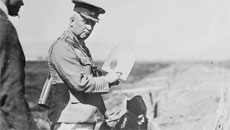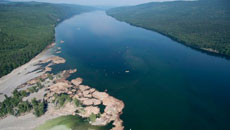A tenacious spell of hot, dry weather in British Columbia has painted a forest-protection map of the province a combination of bright red and dun brown, showing high or extreme fire danger ratings over much of B.C.
With one brief exception, the weather has remained unseasonably warm and dry starting in early July, said Navi Saini, a provincial fire information officer.
"Weather is the number one indicator for fire activity. It is hot and dry and we are expecting those conditions to continue," she said, adding the brief forecast for rain in coastal areas probably would not be enough to bring down the provincial danger rating.
This season, hundreds of fires have stretched manpower thin and blown the provincial firefighting budget to bits.
The cost of fighting fires in the province has leaped to $177 million so far this season. The budget-conscious provincial government set aside just $63 million to fight the summer fires.
The largest fire burning in the province is the Chelaslie River fire estimated to be about 886 square kilometres, located near the boundary of the Northwest and Cariboo fire centres.
More than 280 people are working on the massive fire along with 20 helicopters and 20 pieces of heavy equipment.
Saini said they're only attacking the fire where they it's needed, in a modified response.
"What that means is that we're not actively suppressing the fire in areas where no values are being threatened."
She said the Chelaslie fire is also responsible for a lot of smoke being reported in the northern and central part of B.C.
Numerous air quality advisories have been issued and withdrawn in the province because of fires around the province.
Dozens of people were placed on evacuation alert Tuesday after the Vowell Creek fire, in the Purcell Mountains in southeastern B.C., spread to about four square kilometres in size.
The fire is getting close to a CMH Bobbie Burns Lodge used by hikers in the summer and alpine and heli-skiers in the winter.
Fire information officer Noelle Kekula said a few dozen vacationers are staying there and if the winds shift to the west, the fire will go straight to the lodge.
Wildfire management crews are also doing their best to keep traffic flowing on Highway 20 near Alexis Creek in the central Interior as a wildfire flares nearby.
Cariboo Fire Centre information officer Sandra Wagner said flaggers were on the highway monitoring traffic flow through the only route linking the central coast community of Bella Coola to the rest of the province.
The highway was closed briefly Tuesday morning and could be closed again as the blaze near Bull Canyon has grown to six square kilometres since it was sparked on Monday.
Later on Tuesday, the Cariboo Regional District issued an evacuation alert for nine homes in the area. Residents were warned they might have to leave their homes at a moments notice.
Wagner said more aggressive activity is expected before rain and cooler weather could offer a reprieve later this week.
The dry conditions have prompted the neighbouring Northwest Fire Centre to announce campfire bans, effective Tuesday in the Nadina and Bulkley fire zones and most of the Skeena fire zone. Campfire bans are in place in every district but Prince George.
The Wildfire Management Branch reports 113 large or potentially threatening wildfires are burning across the province.






